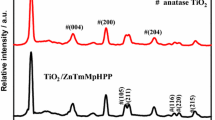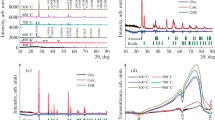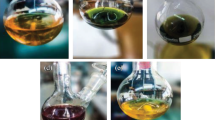Abstract
This paper presents the effects of operating parameters on the photocatalytic degradation of methylene blue using flowerlike rutile-phase TiO2 films synthesised by a hydrothermal method. The findings show that numerous parameters such as the catalyst morphology, the presence of oxygen vacancy/Ti3+ surface defects, initial pH of methylene blue solution, active species, and initial concentration of methylene blue influence the photocatalytic degradation of the dye. Based on the results obtained, the presence of oxygen vacancy/Ti3+ surface defects act as an electron trap that helps generate more electrons and holes, which contributes to the enhancement of the photocatalytic activity of the TiO2 film. This study reveals that the optimum concentration of Ti precursor was obtained at 0.10 M, which produced a flowerlike morphology with pristine rutile-phase that reached 42% methylene blue dye degradation. The effectiveness of the optimised film was boosted by 18% degradation by adjusting the initial pH of the methylene blue solution to 12. Under such conditions, the enhancement of the electrostatic attraction between the negatively charged TiO2 and the methylene blue molecules improved the degradation. No severe deactivation of the catalyst was found even after five photocatalysis reaction cycles. This study also demonstrates that there are multiple parameters involved in optimising the photocatalytic activity of TiO2.









Similar content being viewed by others
References
Arora C, Soni S, Sahu S et al. (2019) Iron based metal organic framework for efficient removal of methylene blue dye from industrial waste. J Mol Liq 284:343–352. https://doi.org/10.1016/j.molliq.2019.04.012
Eljiedi AAA, Kamari A (2017) Removal of methyl orange and methylene blue dyes from aqueous solution using lala clam (Orbicularia orbiculata) shell. AIP Conf Proc 1847:40003. https://doi.org/10.1063/1.4983899
Taylor P, Hanis N, Hairom H et al. (2014) Utilization of self-synthesized ZnO nanoparticles in MPR for industrial dye wastewater treatment using NF and UF membrane. Desalin Water Treat 37–41. https://doi.org/10.1080/19443994.2014.917988
Akpan UG, Hameed BH (2009) Parameters affecting the photocatalytic degradation of dyes using TiO2-based photocatalysts: a review. Hazard Mater 170:520–529. https://doi.org/10.1016/j.jhazmat.2009.05.039
Shoabargh, S. Karimi A, Dehghanb G, Khataee A (2016) A hybrid photocatalytic and enzymatic process using glucose oxidase immobilized on TiO2/polyurethane for removal of a dye. Ind Eng Chem Res 2–9. https://doi.org/10.1016/j.jiec.2013.11.058
Arabatzis IM, Antonaraki S, Stergiopoulos T et al. (2002) Preparation, characterization and photocatalytic activity of nanocrystalline thin film TiO2 catalysts towards 3,5-dichlorophenol degradation. J Photochem Photobiol A Chem 149:237–245. https://doi.org/10.1016/S1010-6030(01)00645-1
Hanis N, Hairom H, Wahab A et al. (2015) Influence of zinc oxide nanoparticles in the nanofiltration of hazardous Congo red dyes. Chem Eng J 260:907–915. https://doi.org/10.1016/j.cej.2014.08.068
Dong H, Zeng G, Tang L et al. (2015) An overview on limitations of TiO2-based particles for photocatalytic degradation of organic pollutants and the corresponding countermeasures. Water Res 79:128–146. https://doi.org/10.1016/j.watres.2015.04.038
Park JH, Kim S, Bard AJ (2006) Novel carbon-doped TiO2 nanotube arrays with high aspect ratios for efficient solar water splitting. Nano Lett 6:24–28. https://doi.org/10.1021/nl051807y
Tao Y, Han Z, Cheng Z et al. (2015) Synthesis of nanostructured TiO2 photocatalyst with ultrasonication at low temperature Journal of Materials Science and Chemical Engineering 3:29–36
Zhang J, Zhou P, Liu J, Yu J (2014) New understanding of the difference of photocatalytic activity among anatase, rutile and brookite TiO2. Phys Chem Chem Phys 16:20382–20386. https://doi.org/10.1039/c4cp02201g
Zhao B, Zhou J, Chen Y, Peng Y (2011) Effect of annealing temperature on the structure and optical properties of sputtered TiO2 films. J Alloys Compd 509:4060–4064. https://doi.org/10.1016/j.jallcom.2011.01.020
Monai M, Montini T, Fornasiero P (2017) Brookite: nothing new under the Sun? Catalysts 7:1–19. https://doi.org/10.3390/catal7100304
Qian X, Han H, Chen Y, Yuan Y (2018) Sol–gel solvothermal route to synthesize anatase/brookite/rutile TiO2 nanocomposites with highly photocatalytic activity. J Sol-Gel Sci Technol 85:394–401. https://doi.org/10.1007/s10971-017-4544-3
Ramirez-Sant A, Acevedo-Peña P, Córdoba EM (2012) Enhanced photocatalytic activity of TiO2 film by modification with polyethylene glycol Quim Nov 35:1931–1935
Sabry RS, Muhsin YKA (2016) Synthesis and photocatalytic activity of TiO2 nanoparticles prepared by sol–gel method. J Sol-Gel Sci Technol 78:299–306. https://doi.org/10.1007/s10971-015-3949-0
Jung HS, Kim H (2009) Origin of low photocatalytic activity of Rutile TiO2. Electron Mater Lett 5:73–76. https://doi.org/10.3365/eml.2009.06.073
Zhang J, Liu P, Lu Z et al. (2015) One-step synthesis of rutile nano-TiO2 with exposed {111} facets for high photocatalytic activity. J Alloy Compd J 632:133–139. https://doi.org/10.1016/j.jallcom.2015.01.170
Kamalia N, Hamed A, Mahat R et al. (2016) Dye-sensitized solar cell using spray pyrolysis deposition method. Journal of Engineering and Applied Sciences 11:8846–8851
Hamed NKA (2016) Influence of hydrochloric acid volume on the growth of titanium dioxide (TiO2) nanostructures by hydrothermal method. Sains Malaysiana 45:1669–1673
Lee DY, Kim JT, Park JH et al. (2013) Effect of Er doping on optical band gap energy of TiO2 thin films prepared by spin coating. Curr Appl Phys 13:1301–1305. https://doi.org/10.1016/j.cap.2013.03.025
Shinde DB, Jagadale SK, Mane RK, Mane RM, Ghanwat VB(2015) Time dependent facile hydrothermal synthesis of TiO2 nanorods and their photoelectrochemical applications J Nanomed Nanotechnol S7:004. https://doi.org/10.4172/2157-7439.S7-004
Zhao Z, Zhang X, Zhang G et al. (2015) Effect of defects on photocatalytic activity of rutile TiO2 nanorods. Nano Res 8:4061–4071. https://doi.org/10.1007/s12274-015-0917-5
Savage N, Diallo MS (2005) Nanomaterials and water purification: opportunities and challenges. J Nanoparticle Res 7:331–342. https://doi.org/10.1007/s11051-005-7523-5
Jordan V, Javornik U, Plavec J et al. (2016) Self-assembly of multilevel branched rutile-type TiO2 structures via oriented lateral and twin attachment. Sci Rep 6:1–13. https://doi.org/10.1038/srep24216
Ye M, Liu H-Y, Lin C, Lin Z (2013) Hierarchical rutile TiO2 flower cluster-based high efficiency dye-sensitized solar cells via direct hydrothermal growth on conducting substrates. Small 9:312–321. https://doi.org/10.1002/smll.201201590
Lazar MA, Varghese S, Nair SS (2012) Photocatalytic water treatment by titanium dioxide: recent updates. Catalyst 2:572–601. https://doi.org/10.3390/catal2040572
Wu G, Wang J, Thomas DF, Chen A (2008) Synthesis of F-doped flower-like TiO2 nanostructures with high photoelectrochemical activity. Langmuir 24:3503–3509
Rashid SA (2010) Immobilisation of titanium dioxide onto supporting materials in heterogeneous photocatalysis: A review. Appl Catal A Gen 389:1–8. https://doi.org/10.1016/j.apcata.2010.08.053
Hamed NKA, Ahmad MK, Hairom NHH et al. (2020) Dependence of photocatalysis on electron trapping in Ag-doped flowerlike rutile-phase TiO2 film by facile hydrothermal method. Appl Surf Sci 534:147571. https://doi.org/10.1016/j.apsusc.2020.147571
Lin X, Sun M, Gao B et al. (2021) Hydrothermally regulating phase composition of TiO2 nanocrystals toward high photocatalytic activity. J Alloys Compd 850:156653. https://doi.org/10.1016/j.jallcom.2020.156653
Mamun K, Asw R, Fahmida K (2017) Parameters affecting the photocatalytic degradation of dyes using TiO2: a review. Appl Water Sci 7:1569–1578. https://doi.org/10.1007/s13201-015-0367-y
Ling CM, Mohamed AR, Bhatia S (2004) Performance of photocatalytic reactors using immobilized TiO2 film for the degradation of phenol and methylene blue dye present in water stream. Chemosphere 57:547–554. https://doi.org/10.1016/j.chemosphere.2004.07.011
Lai Z, Peng F, Wang H et al. (2013) A new insight into regulating high energy facets of rutile TiO2. J Mater Chem A 1–4. https://doi.org/10.1039/c3ta00188a
Meng X, Shin D, Yu SM et al. (2014) Formation mechanism of Rutile TiO2 rods on fluorine doped tin oxide. J Nanosci Nanotechnol 14:8839–8844. https://doi.org/10.1166/jnn.2014.10016
Huyen T, Chi T, Dung N et al. (2018) Enhanced photocatalytic activity of {110}-faceted TiO2 rutile nanorods in the photodegradation of hazardous pharmaceuticals. Nanomaterials 8:276. https://doi.org/10.3390/nano8050276
Yusoff MM, Mamat MH, Ismail AS et al. (2018) Enhancing the performance of self-powered ultraviolet photosensor using rapid aqueous chemical-grown aluminum-doped titanium oxide nanorod arrays as electron transport layer. Thin Solid Films 655:1–12. https://doi.org/10.1016/j.tsf.2018.03.091
Mathews NR, Morales ER, Cortés-Jacome MA, Toledo Antonio JA (2009) TiO2 thin films – Influence of annealing temperature on structural, optical and photocatalytic properties. Sol Energy 83:1499–1508. https://doi.org/10.1016/j.solener.2009.04.008
Santara B, Giri PK, Imakita K, Fujii M (2014) Microscopic origin of lattice contraction and expansion in undoped Rutile TiO2 nanostructures. J Phys D Appl Phys 47:215302
Ahmad MK, Mokhtar SM, Soon CF et al. (2016) Raman investigation of rutile-phased TiO2 nanorods/nanoflowers with various reaction times using one step hydrothermal method. J Mater Sci Mater Electron 27:7920–7926. https://doi.org/10.1007/s10854-016-4783-z
Hernandes J.V, Coste S, García A (2017) Effects of metal doping (Cu, Ag, Eu) on the electronic and optical behavior of nanostructured TiO2 Journal of Alloys and Compound 710:355–363. https://doi.org/10.1016/j.jallcom.2017.03.275
Khan MM, Ansari SA, Pradhan D et al. (2014) Band gap engineered TiO2 nanoparticles for visible light induced photoelectrochemical and photocatalytic studies. J Mater Chem 2:637–644. https://doi.org/10.1039/c3ta14052k
Zuo F, Bozhilov K, Dillon RJ et al. (2012) Active facets on titanium (III)-doped TiO2: an effective strategy to improve the visible-light photocatalytic activity. Angew Chemie Int Ed 51:6223–6226. https://doi.org/10.1002/anie.201202191
Park H, Park Y, Kim W, Choi W (2013) Surface modification of TiO2 photocatalyst for environmental applications. J Photochem Photobiol C Photochem Rev 15:1–20. https://doi.org/10.1016/j.jphotochemrev.2012.10.001
Daviosdóttir S, Dirscherl K, Canulescu S et al. (2013) Nanoscale surface potential imaging of the photocatalytic TiO2 films on aluminum. RSC Adv 3:23296–23302. https://doi.org/10.1039/c3ra43082k
Lai YK, Sun L, Chen C et al. (2005) Optical and electrical characterization of TiO2 nanotube arrays on titanium substrate. 252:1101–1106. https://doi.org/10.1016/j.apsusc.2005.02.035
Mathew S, Prasad AK, Benoy T et al. (2012) UV-visible photoluminescence of TiO2 nanoparticles prepared by hydrothermal method. J Fluoresc 22:1563–1569. https://doi.org/10.1007/s10895-012-1096-3
Xiong L, Li J, Yang B, Yu Y (2012) Ti3+ in the surface of titanium dioxide: generation, properties and photocatalytic application. J Nanomater. https://doi.org/10.1155/2012/831524
Pan X, Yang M, Zhang N (2013) Defective TiO2 with oxygen vacancies: Synthesis, properties and photocatalytic applications. Nanoscale 5:3601–3614. https://doi.org/10.1039/c3nr00476g
Rajabi M, Shogh S, Iraji Zad A (2015) Defect study of TiO2 nanorods grown by a hydrothermal method through photoluminescence spectroscopy. J Lumin 157:235–242. https://doi.org/10.1016/j.jlumin.2014.08.035
Pauly TR, Liu Y, Pinnavaia TJ et al. (1999) Textural mesoporosity and the catalytic activity of mesoporous molecular sieves with wormhole framework structures. J Am Chem Soc 121:8835–8842
Nakata K, Fujishima A (2012) TiO2 photocatalysis: design and applications. J Photochem Photobiol C Photochem Rev 13:169–189. https://doi.org/10.1016/j.jphotochemrev.2012.06.001
Harish S, Archana J, Navaneethan M et al. (2016) Enhanced visible light induced photocatalytic activity on the degradation of organic pollutants by SnO nanoparticle decorated hierarchical ZnO nanostructures. RSC Adv 6:89721–89731. https://doi.org/10.1039/c6ra19824d
Cavigli L, Bogani F, Vinattieri A et al. (2009) Volume versus surface-mediated recombination in anatase TiO2 nanoparticles. J Appl Phys 106:053516. https://doi.org/10.1063/1.3211291
Mustapha F, Jalil AA, Mohamed M et al. (2017) New insight into self-modified surfaces with defect-rich rutile TiO2 as a visible-light-driven photocatalyst new insight into self-modified surfaces with defect-rich rutile TiO2 as a visible-light-driven photocatalyst. J Clean Prod 168:1150–1162. https://doi.org/10.1016/j.jclepro.2017.09.095
Sabarinathan M, Harish S, Archana J et al. (2016) Controlled exfoliation of monodispersed MoS2 layered nanostructures by a ligand-assisted hydrothermal approach for the realization of ultrafast degradation of an organic pollutant. RSC Adv 6:109495–109505. https://doi.org/10.1039/c6ra24355j
Franco Arias LM, Arias Duran A, Cardona D, Camps E, Gómez GZ ME (2015) Effect of annealing treatment on the photocatalytic activity of TiO2 thin films deposited by dc reactive magnetron sputtering. J Phys 614:1–6. https://doi.org/10.1088/1742-6596/614/1/012008
Dulian P, Nachit W, Jaglarz J et al. (2019) Photocatalytic methylene blue degradation on multilayer transparent TiO2 coatings. Opt Mater (Amst) 90:264–272. https://doi.org/10.1016/j.optmat.2019.02.041
Retamoso C, Escalona N, González M et al. (2019) Effect of particle size on the photocatalytic activity of modified rutile sand (TiO2) for the discoloration of methylene blue in water. J Photochem Photobiol A Chem 378:136–141. https://doi.org/10.1016/j.jphotochem.2019.04.021
Sun Y, Qian J, Zhao QR et al. (2021) Hydrothermal synthesis of rutile TiO2 nanotubes film on Ti foil for photocatalytic degradation. Dig J Nanomater Biostructures 16:579–584
Hamed NKA, Ahmad MK, Mazlan MH et al. (2019) Low temperature fabrication of flower-like rutile phased TiO2 film towards methyl orange degradation. Int J Eng Technol 8:49–55
Ahmad MK, Fitrah A, Aziz A et al. (2017) Rutile phased titanium dioxide (TiO2) nanorod/nano flower based waste water treatment device. https://doi.org/10.1007/978-3-319-46490-9
Acknowledgements
The authors would like to thank the Ministry of Higher Education for the financial support under the Fundamental Research Grant Scheme (FRGS) number: FRGS/1/2020/STG05/UTHM/02/4. The authors would also like to thank the Centre for Instrumental Analysis, Shizuoka University, Hamamatsu, Japan for the characterisation equipment.
Author contribution
N.K.A.H.: investigation and writing—original draft. M.K.A.: conceptualisation and supervision. N.H.H.H.: formal analysis and validation. A.B.F.: writing—review and editing and resources. A.B.S. and S.M.M.: conceptualisation and methodology. M.H.M.: writing—review and editing, and validation. M.S.: conceptualisation and supervision. F.I.M.F.: conceptualisation. A.M.: writing—editing. A.M.: validation. M.F.M.S.: writing—review.
Author information
Authors and Affiliations
Corresponding author
Ethics declarations
Conflict of interest
The authors declare no competing interests.
Ethical approval
This article does not contain any studies with human participants or animals performed by any of the authors.
Additional information
Publisher’s note Springer Nature remains neutral with regard to jurisdictional claims in published maps and institutional affiliations.
Supplementary Information
Rights and permissions
About this article
Cite this article
Hamed, N.K.A., Ahmad, M.K., Hairom, N.H.H. et al. Photocatalytic degradation of methylene blue by flowerlike rutile-phase TiO2 film grown via hydrothermal method. J Sol-Gel Sci Technol 102, 637–648 (2022). https://doi.org/10.1007/s10971-021-05691-y
Received:
Accepted:
Published:
Issue Date:
DOI: https://doi.org/10.1007/s10971-021-05691-y




